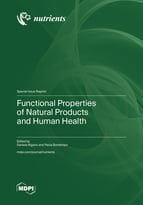Functional Properties of Natural Products and Human Health
A special issue of Nutrients (ISSN 2072-6643). This special issue belongs to the section "Phytochemicals and Human Health".
Deadline for manuscript submissions: closed (20 December 2022) | Viewed by 53400
Special Issue Editors
Interests: natural products; structure elucidation; essential oils; NMR spectroscopy; GC-MS and LC-MS
Special Issues, Collections and Topics in MDPI journals
Interests: anthocyanin; metabolite; natural compounds; antioxidant; cancer; cell proliferation; cell differentiation; bioactive molecules; epigenetics; epidrugs; molecular simulations; endocrine disruptors
Special Issues, Collections and Topics in MDPI journals
Special Issue Information
Dear Colleagues,
Natural products (NPs) isolated from natural sources, and particularly from medicinal plants, are widely used as therapeutic agents for treating diseases and maintaining health and “wellness”. NPs are regarded as an important repository for the development of potential novel drugs, as they may serve as either drug candidates or lead compounds for drug design. Plant-derived therapeutics have several advantages, including wide availability, diverse pharmacological actions, and a generally good profile of safety and tolerability. In recent years, there have been numerous reports from clinical studies testifying the efficacy of medicinal plants and phytochemicals in ameliorating several human diseases such as cancers and inflammatory, fibrotic, cardiovascular, and infectious diseases. A plethora of basic in vitro and in vivo studies have also unraveled molecular mechanisms underlying NPs’ health benefits. Nevertheless, issues such as NP accessibility, sustainable supply, and bioavailability require further study.
The purpose of this Special Issue is to collect original research articles, short communications, and reviews on new perspectives in chemical and functional properties of natural products, including the molecular mechanisms of the therapeutic effects of natural products in human diseases. The submission of studies aimed at characterizing the bioavailability and biological effects of NPs will also be welcomed.
Prof. Dr. Daniela Rigano
Prof. Dr. Paola Bontempo
Guest Editors
Manuscript Submission Information
Manuscripts should be submitted online at www.mdpi.com by registering and logging in to this website. Once you are registered, click here to go to the submission form. Manuscripts can be submitted until the deadline. All submissions that pass pre-check are peer-reviewed. Accepted papers will be published continuously in the journal (as soon as accepted) and will be listed together on the special issue website. Research articles, review articles as well as short communications are invited. For planned papers, a title and short abstract (about 100 words) can be sent to the Editorial Office for announcement on this website.
Submitted manuscripts should not have been published previously, nor be under consideration for publication elsewhere (except conference proceedings papers). All manuscripts are thoroughly refereed through a single-blind peer-review process. A guide for authors and other relevant information for submission of manuscripts is available on the Instructions for Authors page. Nutrients is an international peer-reviewed open access semimonthly journal published by MDPI.
Please visit the Instructions for Authors page before submitting a manuscript. The Article Processing Charge (APC) for publication in this open access journal is 2900 CHF (Swiss Francs). Submitted papers should be well formatted and use good English. Authors may use MDPI's English editing service prior to publication or during author revisions.
Keywords
- natural products
- medicinal plant
- food plant
- bioactive molecules
- biological activity
- human health
- human diet
- molecular mechanism








